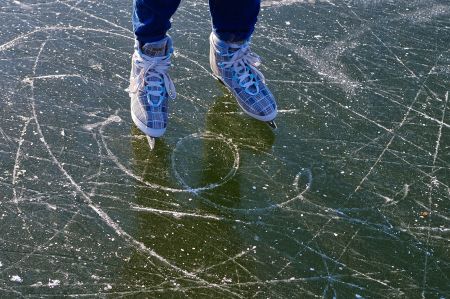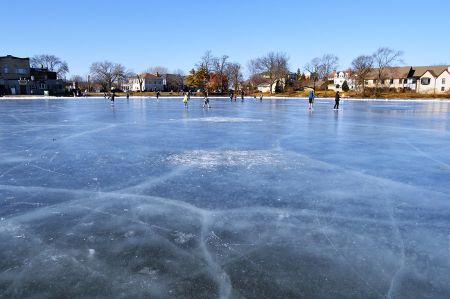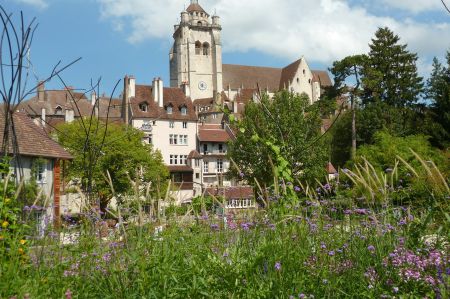Ice skating on Rhine-Rhone Canal with Patrick
- Written by Portal Editor
Some inspirational images of the frozen Rhine-Rhone Canal south of Strasbourg in winter, sent to us by our friend and paraglider Patrick Andre from France, inspired us to write an article about ice skating, a still little practiced outdoor sport in Turkey.
Especially due to the heavy shipping traffic on the Rhine-Rhone Canal, complete icing is already a very rare event, especially where the thickness of the ice was more than 20 centimeters and the ice appeared as smooth as glass. The winter temperatures, especially in central and eastern Anatolia, would offer excellent opportunities to practice this great outdoor sport. Ice rinks are only set up and open to the public in a few large cities, such as Izmir.
About ice-skating development in Europe
 The history of ice skating shows an almost infinitely far-reaching history in many countries around the world, as evidenced by finds and excavations. Of course, the background at that time was not just fitness and health, when people “went onto the ice” and came to “runners” for more effective locomotion, which made progress easier. Today it is assumed that the hunting instinct was a key reason for entering the ice surfaces. Aids made of bone were quickly made, which significantly supported gliding on the ice. Finds in Russia, Scandinavia, Great Britain, Germany and Switzerland prove that ice skates were made of bone. At the beginning of the 20th century, when around 60 centimeters long metacarpus bones were excavated, which had been ground on the side, it was assumed that they had been prepared for use on ice. Estimated age about 20,000 years.
The history of ice skating shows an almost infinitely far-reaching history in many countries around the world, as evidenced by finds and excavations. Of course, the background at that time was not just fitness and health, when people “went onto the ice” and came to “runners” for more effective locomotion, which made progress easier. Today it is assumed that the hunting instinct was a key reason for entering the ice surfaces. Aids made of bone were quickly made, which significantly supported gliding on the ice. Finds in Russia, Scandinavia, Great Britain, Germany and Switzerland prove that ice skates were made of bone. At the beginning of the 20th century, when around 60 centimeters long metacarpus bones were excavated, which had been ground on the side, it was assumed that they had been prepared for use on ice. Estimated age about 20,000 years.
There is reliable evidence of the use of bones for locomotion on ice from around 3,000 BC. Made from the bones of various animal species such as horses, cattle or reindeer, the bones were split, ground flat and angular, pierced and then attached to shoes with straps. Sharpened sticks were often used for propulsion. The British archaeologist V.G. Childe, who was able to examine and identify a bone ice skate from Veseli u Trnavy in Slovakia that is at least 5,000 years old. In Central Europe, pig's foot bones were often used as a gliding aid on the ice, but it is at least questionable whether this is where the term "eisbein" comes from as a delicacy. These bone skates were still in use in some countries like England, Norway and Iceland into the 19th century.
Oldest steel skates in Budapest Museum
 The oldest steel skates in Hungary, around 2,000 years old, were found in the ore foundry workshop of a Celtic master and are now in the Budapest Museum. In Holland in the 14th century the development of wooden ice skates into which iron fittings had been inserted began. Initially installed flat in the foot-shaped wooden body, the construction was changed and the metal was now inserted vertically into the wooden body. As before, the construction had to be attached to the shoes with straps. Hollow grinds or even spikes for better repulsion and/or braking were still unknown, so sticks were still used for propulsion. Only in the 15th century were the Dutch again using runners with 2 edges and a groove in between, which meant that sticks could be dispensed with.
The oldest steel skates in Hungary, around 2,000 years old, were found in the ore foundry workshop of a Celtic master and are now in the Budapest Museum. In Holland in the 14th century the development of wooden ice skates into which iron fittings had been inserted began. Initially installed flat in the foot-shaped wooden body, the construction was changed and the metal was now inserted vertically into the wooden body. As before, the construction had to be attached to the shoes with straps. Hollow grinds or even spikes for better repulsion and/or braking were still unknown, so sticks were still used for propulsion. Only in the 15th century were the Dutch again using runners with 2 edges and a groove in between, which meant that sticks could be dispensed with.
It was not until the 19th century that constructions were possible that replaced the strap construction as a holding device, initially by means of a screw and later by clamping directly on the sole of the shoe. This type of skate attachment was widespread in Europe well into the 1950s and 1960s. As early as 1865, the American figure skater had developed all-metal skates that were connected to the shoe sole and thus offered considerable advantages. The Swedish figure skater and 10-time world champion Ulrich Salchow then developed the tips on the skates, which allowed him to accelerate much faster, which led to the first jumps on the ice. This development was continuously continued, so that today we basically find two rough subdivisions: ice hockey skates and freestyle skates (with and without spikes).
With Patrick Andre skating Rhine-Rhone-Canal
 In the development of ice skating, large shares go to the Dutch, who sent their royal messengers down the canals to deliver messages as early as 800 years ago. Initially, in the development of a leisure activity for the nobility, the people were also involved in steps, so that it could slowly develop into a national sport. Even today there are some very well-known events with a long tradition, such as the Dutch Elfstedentocht, where eleven Frisian cities have to be passed through in one day, which corresponds to at least 200 kilometers on the canals. Similarly, in Sweden there is the ice skating marathon from Uppsala to Stockholm, which is also 80 kilometers long.
In the development of ice skating, large shares go to the Dutch, who sent their royal messengers down the canals to deliver messages as early as 800 years ago. Initially, in the development of a leisure activity for the nobility, the people were also involved in steps, so that it could slowly develop into a national sport. Even today there are some very well-known events with a long tradition, such as the Dutch Elfstedentocht, where eleven Frisian cities have to be passed through in one day, which corresponds to at least 200 kilometers on the canals. Similarly, in Sweden there is the ice skating marathon from Uppsala to Stockholm, which is also 80 kilometers long.
In the meantime, it is already a small sensation when large areas of water freeze over at all due to global warming and climate change. While it was just after 15 years that the so-called Alster fun could be held in Hamburg for the first time, one realizes that it is something extraordinary to skate on the Rhine-Rhone Canal, and what's more, on a mirror-smooth ice surface.
Please read as well:
Romkerhaller waterfall in the Okertal in Harz Mountains
Egyptian blue painted on stone slab in Brunn am Gebirge
-
 Skating Rhine-Rhone with Patrick Andre
Skating Rhine-Rhone with Patrick Andre
Skating Rhine-Rhone with Patrick Andre
Skating Rhine-Rhone with Patrick Andre
-
 Skating Rhine-Rhone with Patrick Andre
Skating Rhine-Rhone with Patrick Andre
Skating Rhine-Rhone with Patrick Andre
Skating Rhine-Rhone with Patrick Andre
-
 Skating Rhine-Rhone with Patrick Andre
Skating Rhine-Rhone with Patrick Andre
Skating Rhine-Rhone with Patrick Andre
Skating Rhine-Rhone with Patrick Andre
-
 Skating Rhine-Rhone with Patrick Andre
Skating Rhine-Rhone with Patrick Andre
Skating Rhine-Rhone with Patrick Andre
Skating Rhine-Rhone with Patrick Andre
-
 Skating Rhine-Rhone with Patrick Andre
Skating Rhine-Rhone with Patrick Andre
Skating Rhine-Rhone with Patrick Andre
Skating Rhine-Rhone with Patrick Andre
-
 Skating Rhine-Rhone with Patrick Andre
Skating Rhine-Rhone with Patrick Andre
Skating Rhine-Rhone with Patrick Andre
Skating Rhine-Rhone with Patrick Andre
https://www.alaturka.info/en/france/308-strasbourg/5527-ice-skating-on-rhine-rhone-canal-with-patrick#sigProId02928e0eca
